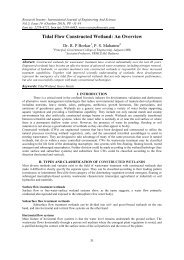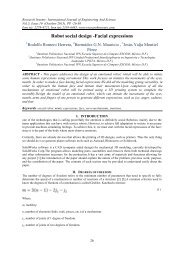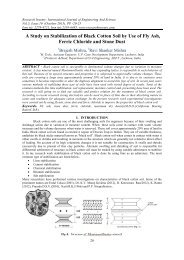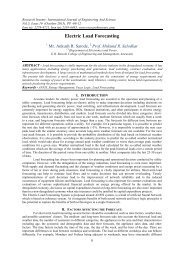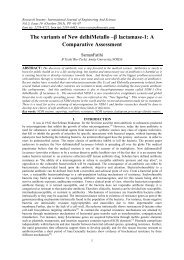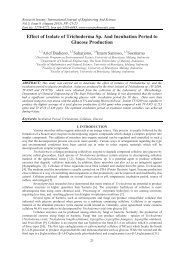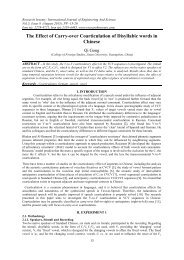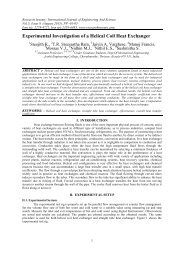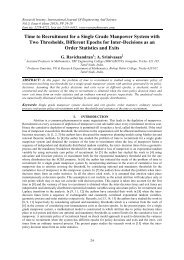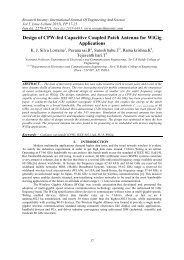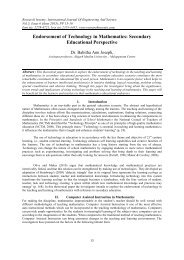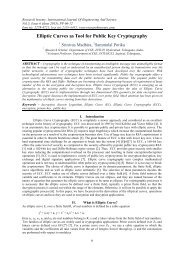Fuzzy Models for Teaching Assessment
- No tags were found...
Create successful ePaper yourself
Turn your PDF publications into a flip-book with our unique Google optimized e-Paper software.
85,85,75,77,79 ,60,61,63,51,51,50,40,42.<br />
Department 2(D2- Business administration):<br />
90,84,82,74,73,70,59,58,48,45,45.<br />
The results of the faculties’ per<strong>for</strong>mance are summarized in table 1 below:<br />
Table 1: Results of D1and D2<br />
Grade D1 D2<br />
A 2 1<br />
B 3 2<br />
C 3 3<br />
D 3 2<br />
F 2 3<br />
Total 13 11<br />
11<br />
<strong>Fuzzy</strong> <strong>Models</strong> For <strong>Teaching</strong>…<br />
The evaluation of the above results will be per<strong>for</strong>med below using both traditional methods, based on principles<br />
of the classical (bivalent) logic, and fuzzy logic methods.<br />
4.1 Traditional methods<br />
i) Calculations of the means: A straight<strong>for</strong>ward calculation gives that the means of the faculties’ scores<br />
are approximately 63 and 66.18 <strong>for</strong> D1 and D2 respectively. This shows that the mean per<strong>for</strong>mance was good<br />
(C) <strong>for</strong> the both department D1 and D2.<br />
Comparing D1 and D2 ,D2 is better than D1.<br />
ii) Calculation of the GPA index: We recall that the Great Point Average (GPA) index is a weighted<br />
mean, where more importance is given to the higher scores by attaching greater coefficients (weights) to them<br />
(e.g. see [16]). In other words, the GPA index focuses on the quality per<strong>for</strong>mance of a faculty group.<br />
Let us denote by , , , and the numbers of faculties of a given group whose per<strong>for</strong>mance is<br />
characterized by A, B, C, D and F respectively and by n the total number of faculties of the group. Then, the<br />
GPA index is calculated by the <strong>for</strong>mula<br />
GPA = .<br />
Obviously we that 0<br />
. In our case the above <strong>for</strong>mula can be written as GPA=<br />
(7). Then, using the data of table 1 it is easy to check that the GPA <strong>for</strong> D1 is equal to<br />
and <strong>for</strong> D2 is equal to<br />
. There<strong>for</strong>e, since the values of the GPA index are less than the half of<br />
its maximal possible value , which is equal to 4, the quality per<strong>for</strong>mance of D1 was satisfactory and D2 was<br />
less than satisfactory. However, in contrast to their mean per<strong>for</strong>mances, the quality per<strong>for</strong>mance of both D1 and<br />
D2 were good.<br />
4.2 <strong>Fuzzy</strong> logic methods<br />
In this paragraph we shall apply the fuzzy logic methods described in sections 2 and 3 of this paper<br />
as follows:<br />
iii) The COG method: Observing the coefficients of the s, i = 1, 2, 3, 4, 5 in the first of <strong>for</strong>mulas (3) and<br />
taking into account that, according to the criterion stated in section 2, the COG abscissa measures a faculty<br />
group’ per<strong>for</strong>mance, it becomes evident that the COG method is also focused , as the GPA index does, on the<br />
faculty groups’ quality per<strong>for</strong>mance.<br />
In case of our classroom application taking into account the data of table 1 and using the first of<br />
<strong>for</strong>mulas (3) we find that <strong>for</strong> D1 and <strong>for</strong> D2. Since the above value of are<br />
more than the half of its value in the ideal case, which is equal to (see section 2), the quality per<strong>for</strong>mance of<br />
both department according was more than the satisfactory. Further, D1 demonstrated a better quality<br />
per<strong>for</strong>mance than D2.<br />
iv) Application of TFAM: Observing the coefficients of the s, i = 1, 2, 3, 4, 5 in the first of <strong>for</strong>mulas (5)<br />
it is easy to conclude that the COG method is also focused on the faculty groups’ quality per<strong>for</strong>mance.<br />
In case of our classroom application taking into account the data of table 1 and using the first of<br />
<strong>for</strong>mulas (5) we find that <strong>for</strong> D1 and <strong>for</strong> D2. In this case the value of<br />
are more than the half of its value in the ideal case, which is equal to 33 (see section 3), the quality per<strong>for</strong>mance<br />
of both department according was more than the satisfactory. Further, D1 demonstrated a better quality<br />
per<strong>for</strong>mance than D2.<br />
4.3 Comparison of the assessment method used



